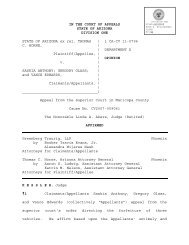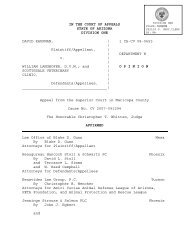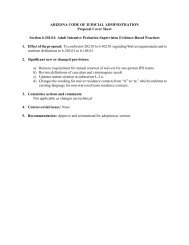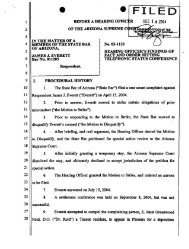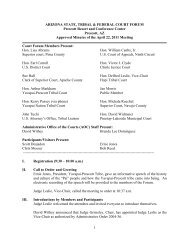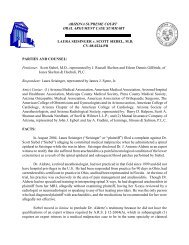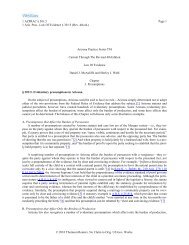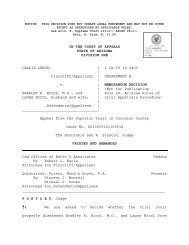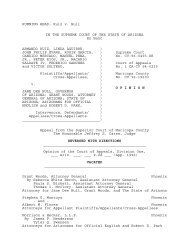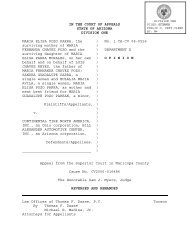State v. Kendrick - Arizona Judicial Department
State v. Kendrick - Arizona Judicial Department
State v. Kendrick - Arizona Judicial Department
Create successful ePaper yourself
Turn your PDF publications into a flip-book with our unique Google optimized e-Paper software.
IN THE COURT OF APPEALS<br />
STATE OF ARIZONA<br />
DIVISION ONE<br />
STATE OF ARIZONA, ) No. 1 CA-CR 11-0849<br />
) 1 CA-CR 11-0850<br />
Appellee, ) (Consolidated)<br />
)<br />
v. ) DEPARTMENT B<br />
)<br />
JUSTIN SCOTT KENDRICK, )<br />
) O P I N I O N<br />
Appellant. )<br />
__________________________________)<br />
Appeal from the Superior Court in Maricopa County<br />
Cause Nos. CR2010-145260-001 & CR2007-006213-001<br />
The Honorable Joseph C. Kreamer, Judge<br />
REVERSED AND REMANDED WITH INSTRUCTIONS<br />
Thomas C. Horne, <strong>Arizona</strong> Attorney General<br />
Phoenix<br />
By Joseph T. Maziarz, Chief Counsel Criminal Appeals<br />
and Liza-Jane Capatos, Assistant Attorney General<br />
Attorneys for Appellee<br />
James J. Haas, Maricopa County Public Defender<br />
By Charles R. Krull, Deputy Public Defender<br />
Attorneys for Appellant<br />
Phoenix<br />
N O R R I S, Judge<br />
1 The issue in this appeal is whether a probationer’s<br />
unauthorized removal of an electronic monitoring device,<br />
required as a condition of probation, constitutes escape in<br />
violation of <strong>Arizona</strong> Revised Statute (“A.R.S.”) section 13-
2503(A)(2) (Supp. 2012). 1<br />
We hold it does not. Accordingly, we<br />
reverse Justin Scott <strong>Kendrick</strong>’s conviction for escape, vacate<br />
the superior court’s finding that he violated his probation, and<br />
remand for further proceedings consistent with this opinion.<br />
FACTS AND PROCEDURAL BACKGROUND<br />
2 In 2008, <strong>Kendrick</strong> pled guilty in Maricopa County<br />
Superior Court Cause No. CR2007-006213-001 to attempted<br />
molestation of a child and sexual abuse, both class three<br />
felonies and dangerous crimes against children (“2007 case”).<br />
Pursuant to his plea agreement, the superior court suspended<br />
imposition of sentence on each count and placed <strong>Kendrick</strong> on<br />
lifetime probation. As a condition of probation and as required<br />
by A.R.S. § 13-902(G) (Supp. 2012), the superior court subjected<br />
<strong>Kendrick</strong> to global positioning system (“GPS”) monitoring for the<br />
term of his probation (“monitoring order”). 2<br />
1 Although the <strong>Arizona</strong> Legislature amended certain<br />
statutes cited in this opinion after the date of <strong>Kendrick</strong>’s<br />
offense, the revisions are immaterial. Thus, we cite to the<br />
current version of these statutes unless otherwise noted.<br />
2 Section 13-902(G) mandates GPS or electronic<br />
monitoring of registered sex offenders placed on probation for<br />
certain dangerous crimes against children.<br />
2
3 In July 2010, a probation officer petitioned to revoke<br />
<strong>Kendrick</strong>’s probation, alleging he had violated his probation by,<br />
inter alia, interfering with the electronic monitoring device in<br />
violation of A.R.S. § 13-3725 (2010), absconding, and failing to<br />
comply with GPS monitoring as required by A.R.S. § 13-902(G).<br />
Subsequently, and as relevant here, in Maricopa County Superior<br />
Court Cause No. CR2010-145260-001, a grand jury indicted<br />
<strong>Kendrick</strong> for escape in the second degree, a class five felony<br />
(“2010 case”). A.R.S. § 13-2503(A)(2), (B). The petition to<br />
revoke <strong>Kendrick</strong>’s probation and escape charge arose out of his<br />
failure to wear a GPS monitoring device (“GPS unit”) on his<br />
ankle pursuant to the court’s monitoring order.<br />
4 A jury found <strong>Kendrick</strong> guilty of escape. The superior<br />
court sentenced <strong>Kendrick</strong> to a prison term for escape, and found<br />
he had violated his probation in the 2007 case based on his<br />
conviction in the 2010 case.<br />
The court reinstated <strong>Kendrick</strong> on<br />
lifetime probation to begin after his release from prison.<br />
DISCUSSION<br />
5 On appeal, <strong>Kendrick</strong> argues the superior court should<br />
have granted his motion for judgment of acquittal on the escape<br />
charge because the <strong>State</strong> failed to prove he had committed a<br />
“departure from custody . . . with knowledge that such departure<br />
[was] unpermitted” in violation of A.R.S. § 13-2501(4) (Supp.<br />
2012). Although <strong>Kendrick</strong> acknowledges he was required to wear<br />
3
the GPS unit as a condition of probation, he argues that<br />
requirement did not “constitute the constructive restraint<br />
sufficient to satisfy the definition of custody” in A.R.S. § 13-<br />
2501(3), the statute that defines “custody” for purposes of<br />
escape. Reviewing these arguments de novo, we agree. <strong>State</strong> v.<br />
West, 226 Ariz. 559, 562, 15, 250 P.3d 1188, 1191 (2011)<br />
(appellate court reviews ruling on motion for judgment of<br />
acquittal de novo); <strong>State</strong> v. Stauffer, 203 Ariz. 551, 554, 8,<br />
58 P.3d 33, 36 (App. 2002) (appellate court reviews issues of<br />
statutory construction and interpretation de novo).<br />
6 As charged in this case, a person commits escape in<br />
the second degree by knowingly “[e]scaping or attempting to<br />
escape from custody imposed as a result of having been arrested<br />
for, charged with or found guilty of a felony.” A.R.S. § 13-<br />
2503(A)(2).<br />
Under A.R.S. § 13-2501(4), and as relevant here,<br />
“‘[e]scape’ means departure from custody . . . with knowledge<br />
that such departure is unpermitted.” In turn, “‘[c]ustody’<br />
means the imposition of actual or constructive restraint<br />
pursuant to an on-site arrest or court order . . .”<br />
A.R.S.<br />
§ 13-2501(3).<br />
4
7 We have addressed the meaning of “custody” in two<br />
cases where, as here, the defendant removed an electronic<br />
monitoring device.<br />
But in each case, in addition to removing<br />
the device, the defendant also violated a court order that<br />
subjected the defendant to home detention. Thus, in <strong>State</strong> v.<br />
Williams, 186 Ariz. 622, 925 P.2d 1073 (App. 1996), we held the<br />
defendant had violated A.R.S. § 13-2503(A)(2) by removing an<br />
electronic monitoring device and departing from home detention<br />
without authorization. There, we explained: “Defendant’s<br />
removal of the electronic monitoring device and unauthorized<br />
departure from his home and <strong>Arizona</strong> constitute[d] an act of<br />
departing from court-ordered custody.”<br />
Id. at 623, 925 P.2d at<br />
1074. Similarly, in In re Brittany Y., 214 Ariz. 31, 32, 9,<br />
147 P.3d 1047, 1048 (App. 2006), we held a juvenile had violated<br />
A.R.S. § 13-2502(A) (2001) 3 by removing an electronic ankle<br />
monitor and leaving home after the juvenile court had imposed<br />
electronic monitoring and home detention as a condition of the<br />
juvenile’s release pending probation violation proceedings.<br />
8 Here, unlike Williams and Brittany Y., in the 2007<br />
case, the superior court did not order home detention, or<br />
confine <strong>Kendrick</strong> to any particular place, or require him to be<br />
3 Under this statute, a person commits escape in the<br />
third degree by knowingly escaping or attempting to escape from<br />
custody after being arrested for, charged with or found guilty<br />
of a misdemeanor or petty offense.<br />
5
at any place at a particular time.<br />
Although the terms of his<br />
probation prohibited him from going to certain places (for<br />
example, traveling outside Maricopa County or going to places<br />
primarily used by children, without permission from the<br />
probation department), 4<br />
<strong>Kendrick</strong>, who was living at a homeless<br />
shelter when arrested, could otherwise come and go as he pleased<br />
and live where he wished.<br />
9 The <strong>State</strong> argues, however, that the superior court’s<br />
monitoring order by itself constituted a court-ordered<br />
“constructive restraint” under A.R.S. § 13-2501(3). Noting the<br />
Legislature did not define “restraint,” the <strong>State</strong> relies on<br />
dictionary definitions and argues “restraint” should be<br />
construed broadly to include a range of meanings, from “[l]oss<br />
or curtailment of freedom” to “[a]n inhibiting influence.”<br />
Thus, the <strong>State</strong> argues the superior court’s order requiring<br />
<strong>Kendrick</strong> to wear the GPS unit as a condition of probation<br />
constituted a court-ordered “restraint” because it “inhibit[ed]<br />
him from violating the rules imposed as part of his probation<br />
and, at the same time, . . . curtail[ed] his freedom to move<br />
about without constant monitoring by the <strong>State</strong>.”<br />
4 The <strong>State</strong> has not argued that these probation terms<br />
subjected <strong>Kendrick</strong> to “custody” within the meaning of the escape<br />
statute.<br />
6
10 We reject the <strong>State</strong>’s argument that court-ordered<br />
electronic monitoring by itself constitutes restraint and thus,<br />
“custody” under A.R.S. § 13-2501(3).<br />
In construing a statute,<br />
our task is to “fulfill the intent of the legislature that wrote<br />
it.” <strong>State</strong> v. Williams, 175 Ariz. 98, 100, 854 P.2d 131, 133<br />
(1993) (citations omitted). In our view, the <strong>State</strong>’s definition<br />
of restraint goes beyond what the Legislature contemplated in<br />
enacting the escape statutes.<br />
A defendant placed on probation<br />
is subject to a host of restrictions and limitations on his or<br />
her freedom, all of which inhibit, and should inhibit, a<br />
probationer’s conduct. Prohibitions on alcohol consumption,<br />
drug testing requirements, and travel restrictions, to name a<br />
few, come to mind.<br />
Under the <strong>State</strong>’s expansive definition of<br />
restraint -- which could include any probationary term<br />
curtailing freedom or inhibiting conduct -- a probationer who<br />
violated these or other similar probation terms could be charged<br />
with escape.<br />
11 Although we may consider dictionary definitions in<br />
construing words in a statute in the absence of a specific<br />
statutory definition, we must consider their common meaning and<br />
ordinary usage in the context of the statutory scheme, and we<br />
are not obligated to apply all possible definitions.<br />
A.R.S.<br />
§ 1-213 (2002) (directing that words in statutes “be construed<br />
according to the common and approved use of the language”);<br />
7
<strong>State</strong> v. Wise, 137 Ariz. 468, 470 n.3, 671 P.2d 909, 911 n.3<br />
(1983) (“words and phrases in statutes shall be given their<br />
ordinary meaning unless it appears from context or otherwise<br />
that a different meaning is intended”); <strong>State</strong> v. Gray, 227 Ariz.<br />
424, 427, 9, 258 P.3d 242, 245 (App. 2011) (“We recognize that<br />
a dictionary definition may not be conclusive and, because<br />
‘context gives meaning,’ statutory terms should not be<br />
considered in isolation.”) (citation omitted).<br />
12 Further, we are not writing on a clean slate when it<br />
comes to the meaning of “restraint.” Our supreme court<br />
addressed the meaning of the term in the context of custody for<br />
resisting arrest and escape, and stated “the common<br />
understanding of the word connotes controlling, limiting, or<br />
restricting the movement of another.” <strong>State</strong> v. Stroud, 209<br />
Ariz. 410, 412, 9, 103 P.3d 912, 914 (2005). And, in Brittany<br />
Y., we relied on Stroud’s definition of restraint in concluding<br />
the juvenile there was “under restraint and in custody . . .<br />
because the juvenile court had restricted her movement by<br />
ordering home detention and electronic monitoring.”<br />
214 Ariz.<br />
at 32, 9, 147 P.3d at 1048. 5<br />
5<br />
Some states have defined escape to require a form of<br />
detention or confinement, while other states have adopted a more<br />
expansive definition of escape that would include removal of an<br />
electronic monitoring device by itself. Compare Commonwealth v.<br />
Wegley, 829 A.2d 1148, 1152 (Pa. 2003) (home detention and<br />
removal of electronic monitoring device constitutes escape),<br />
8
13 Here, the court-ordered GPS monitoring allowed the<br />
probation department to track <strong>Kendrick</strong>’s movements, but this<br />
monitoring did not confine or restrain his movements.<br />
As his<br />
probation officer testified at trial: “That is the intention of<br />
the GPS device, [it] is for monitoring the person’s whereabouts<br />
at given locations and exact times.” The GPS monitoring did not<br />
constitute “actual or constructive restraint” for purposes of<br />
“custody” under A.R.S. § 13-2501(3), and accordingly, <strong>Kendrick</strong>’s<br />
failure to wear the GPS unit did not constitute a “departure<br />
from custody” -- an essential element of escape -- in violation<br />
of A.R.S. § 13-2503(A)(2). Therefore, we vacate the judgment of<br />
guilt entered against <strong>Kendrick</strong> on the escape charge.<br />
Because<br />
the superior court found <strong>Kendrick</strong> had violated his probation<br />
based on the escape conviction, we also vacate the court’s<br />
finding that <strong>Kendrick</strong> had violated his probation in the 2007<br />
case, and remand that matter for further proceedings consistent<br />
with this opinion.<br />
CONCLUSION<br />
14 For the foregoing reasons, we vacate <strong>Kendrick</strong>’s<br />
conviction and sentence for escape in the second degree in the<br />
with Alaska Stat. § 11.56.310(a)(3) (West 2013) (escape includes<br />
removing, tampering with, or disabling electronic monitoring<br />
equipment), Ind. Code § 35-44.1-3-4(b) (West 2013) (escape<br />
includes violating home detention order or removing electronic<br />
monitoring device), and Minn. Stat. § 609.485 Subd. 2(7) (West<br />
2013) (escape includes absconding from electronic monitoring or<br />
removing electronic monitoring device).<br />
9
2010 case and the superior court’s finding he violated his<br />
probation in the 2007 case. On remand, the superior court shall<br />
enter a judgment of acquittal in the 2010 case, and in the 2007<br />
case conduct further proceedings consistent with this opinion.<br />
/s/<br />
PATRICIA K. NORRIS, Presiding Judge<br />
CONCURRING:<br />
/s/<br />
ANDREW W. GOULD, Judge<br />
/s/<br />
RANDALL M. HOWE, Judge<br />
10




